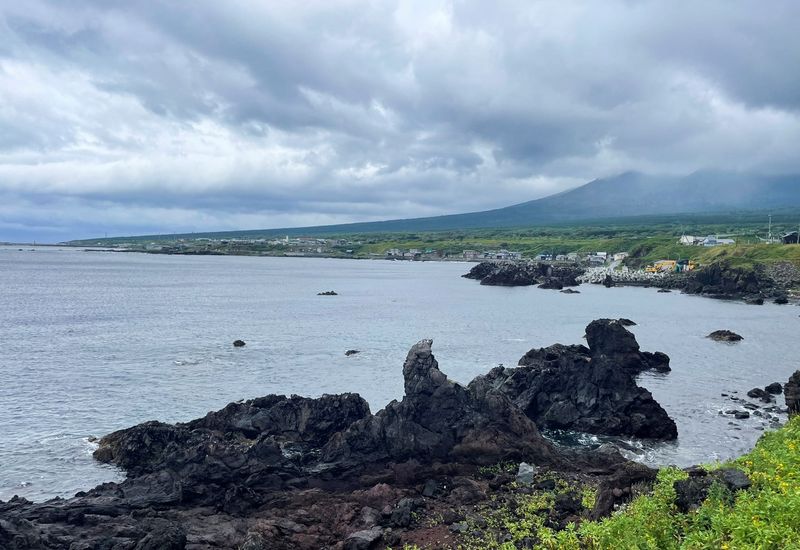By Yuka Obayashi and Katya Golubkova
RISHIRI, Japan (Reuters) -As Japan faces its hottest summer in history, a sharp decline in the catch of sea urchin in the country’s north has made the spiny delicacy further out of reach for many consumers already strained by high food costs.
On Hokkaido’s Rishiri Island, restaurants offer a rice bowl with 100 grams of bafun sea urchin – renowned for its rich sweetness – at a record 15,000–18,000 yen ($100-$120), roughly double what it was several years ago.
“Everyone is shocked when they see the price,” said Kimiko Sato, owner of the Sato Shokudo restaurant across from Rishiri’s Oshidomari ferry terminal, which her family has run for more than 50 years.
“A group of customers would share just one sea urchin bowl, and everyone would order ramen for themselves.”
While sea urchin is traditionally considered a luxury item, the prohibitive price has made it off-limits even for special occasions for many households in Japan, where soaring food costs have become an urgent issue for authorities in Tokyo.
Rising food prices mean an average Japanese household’s spending on food is now at nearly 30%, the highest in 43 years.
Policymakers have mostly blamed the sharp rise in food prices on the weak yen’s upward pressure on import costs – but the effects of global warming now also loom as a risk.
In Rishiri, the catch of sea urchins has halved from last year, according to Tatsuaki Yamakami, executive director at the Rishiri Fisheries Cooperative, continuing a trend he has observed for a few years.
“The prices are soaring due to low catches,” said Yamakami, a 40-year industry veteran. “I think the rising sea temperatures are to blame…it’s a worrying situation.”
According to Yamakami, the top price of 10 kilograms of Rishiri’s bafun sea urchin, which thrives in cold waters, has surged to 90,000 yen—more than double roughly 40,000 yen two years ago.
WARMING WATERS
In recent years, water temperatures around Japan have risen about 5C, said Shigeho Kakehi, a senior research scientist at the Japan Fisheries Research and Education Agency.
The Tohoku region, north of Tokyo, is no longer a major salmon-producing area, a situation further worsened by the northward shift of the warm ocean current.
Volumes of popular cold-water species such as salmon, squid, and saury have dropped sharply over the last 20 years, while their price per kilogram has jumped nearly fivefold, according to Kakehi.
Fish and seafood make up a relatively modest portion of the food basket, or less than 10%, and their contribution to headline inflation is only around 0.1 percentage point.
All the same, it shows the economic effects of climate change are no longer just theoretical, said Stefan Angrick, head of Japan and Frontier Market Economics at Moody’s Analytics.
“Extreme weather events and increased average global temperatures are among the reasons we expect inflation to be structurally higher in the future than in the past,” he said.
Food prices in Japan rose 7.6% in July, year-on-year, speeding up from 7.2% in June, according to government data released last week. Rice, which has also been hit by warmer weather, remains the top contributor to food inflation.
Fresh food, which the Bank of Japan (BOJ) usually excludes from its measurement due to its volatility – rose 3.3% last month from 1.6% in June. Fish and seafood inflation has moderated somewhat recently, to 2.5% from 3.9%.
Research firm Teikoku Databank said in a note on Monday Tokyo’s heatwave hit household spending on seafood, hurt by price hikes as rising temperatures reduced catch volumes.
“We came to Tsukiji to eat our way through the city, but uni donburi and seafood donburi are just too expensive for us,” said Momoko Asami, a 35-year-old tourist visiting the popular Tsukiji seafood market in Tokyo. “So we’re sticking to street foods like monja-croquettes and tamagoyaki.”
While the weak yen, caused by the still large gap between interest rates in Japan and elsewhere, is the main driver of food inflation, climate change is also on the central bank’s radar.
Naoki Tamura, a BOJ board member, in June said the rate of increase in fresh food prices, including seafood, has risen much faster than overall prices since early 2022.
While labour shortages and rising utility and other costs were key, Tamura pointed to the effects of “irregular weather due to climate change,” adding that prices of fresh food and other food have a negative impact on households.
“Japanese inflation remains modest compared to elsewhere, but it is enough to hurt people’s pocketbooks, mainly because salaries have not kept up,” said David Boling, director at Eurasia Group consultancy. “The shift has been difficult, especially for the elderly on fixed incomes.”
Japan aims to raise its overall food self-sufficiency ratio to 69% on a production-value basis by fiscal 2030, up from around 60% now—a target that Kakehi says may be complicated by climate pressure.
“Even if we try very hard (by cutting emissions with renewable energy), the temperature will still rise by about 1–1.5 degrees Celsius by 2100,” he said, noting that the quantity and timing of fishing for spawning fish and newborn fish should be regulated.
“Sardines have been on the rise over the past 7–8 years, we should try to eat more sardines.”
($1 = 147.3500 yen)
(Reporting by Katya Golubkova, Yuka Obayashi, additional reporting by Makiko Yamazaki and Leika Kihara; Editing by Sam Holmes)









